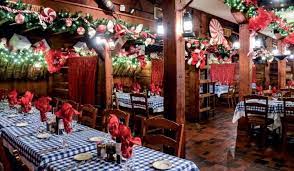
When you think of holiday food, Thanksgiving turkeys, hot cocoa, and candy in stockings come to mind. But in the foodservice industry, there is so much more. Office parties, charity events, edible gifts sent to clients or family members—the holidays are full of seasonal food products. Many foodservice companies make their annual profits during November and December. This year, many operators are poised to do well, as restaurants experienced 23% sales growth over Black Friday Weekend.
So what do effective foodservice operators do to take advantage of this end of year surge? They are using it to drum up business for next year with catering, gifts, and incentives for continued patronage.
- Catering
November and December are full of parties. Whether it is a casual get together to exchange Secret Santa gifts or a formal New Year’s Eve bash, people will get together to share food and celebrate. Foodservice operators in any sector can take advantage of this catering demand. Convenience stores and fast casual sectors, for example, would be well suited to cater morning and afternoon office parties. High end companies can market themselves for evening celebrations and charity balls.
The key is for foodservice operators to develop catering menus that play to their strengths. To do this, prioritize your most profitable and popular menu items and repackage them in a party friendly format. For example, a fast casual operator that focuses on the office lunch crowd might develop sandwich platters to allow for mass production and easy delivery. Depending on the quality of the sandwich fillings, the operator latches onto the charcuterie board trend to make their catering menu even more special.
- Gifts
While most people will not find food under their Christmas tree, edible gifts are incredibly popular during the holidays. Edible options are especially ideal for hostesses, major clients, employees, or relatives who live far away. Like catering, the key here is thoughtful curation. For example, an arrangement of popular, shelf-stable products in a gift basket practically sells itself.
Operators whose products are not immediately “giftable” (i.e., sell products that are temperature sensitive or difficult to transport) can still take advantage of the season with gift certificates. Any teacher will tell you how much they look forward to the avalanche of coffee shop gift cards they receive during the holiday season. In fact, 62% of consumers hope to receive restaurant gift cards during the holidays.
- Incentives for Next Year
During the holiday season, consumers will be encountering many food brands for the first time. Whether they receive an edible gift, go to a catered party, or simply get busy with shopping and pop in for a quick bite to eat, they will be engaging with foodservice at a frenetic pace.
Operators should leverage this high level of engagement to convert consumers into year-round customers. To do this, operators first need to deliver an excellent product during the holidays. Next, they should pair it with a discount or special offer that the consumer can use in the new year. This could be a coupon that takes effect on January 1. For large catering orders, it could take the form of a thank you note in the new year, along with an offer to develop additional catering options for them going forward.
The Bottom Line
By crafting tailored, appropriate catering and gift options, foodservice companies can capture key seasonal demand. If operators pair that engagement with high quality product delivery and an incentive to continue purchasing after the new year, they can foster year-round demand.
To learn more about FSIP’s Management Consulting Practice, click here.
Like the content? Sign up to receive our communications.

Recent Comments